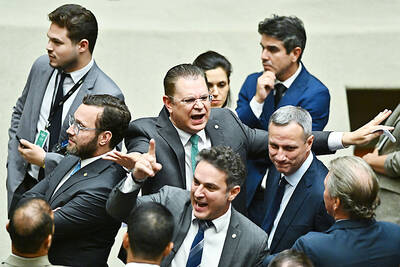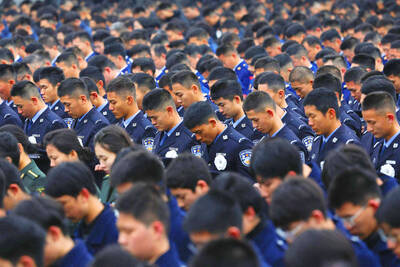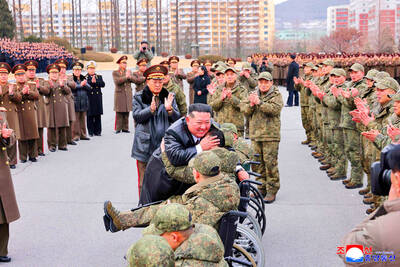Germany’s Holocaust memorial, a solemn maze of concrete gray slabs in central Berlin commemorating the six million Jews murdered by the Nazis, split public opinion when it was erected five years ago.
But now, ahead of next month’s anniversary, the splits are all too real as a viciously cold winter, inferior building materials and possible building flaws have resulted in cracks in more than two-thirds of the 2,711 columns.
“Can the Holocaust memorial still be saved?” mass circulation Bild asked.

PHOTO: AFP
The head of the foundation that manages the memorial, which stretches over 19,000m² at a site close to the Brandenburg Gate, said a committee of experts was looking into the problem.
The committee’s report should “help to clear up what caused the cracks and who is responsible for them, but also to work out an appropriate method of repairing the damage,” Uwe Neumaerker said.
“We’ll find a solution. Whatever happens it will be repaired. But we don’t know exactly when. We have to wait for the results of the report,” said Leonie Mechelhoff, the foundation’s spokeswoman.
The cracks in the columns, which vary from ankle height to 4.7m, “are not dangerous,” said Mechelhoff, adding she was confident the monument would be restored quickly to its former state.
But the fissures are the latest in a series of controversies to dog the memorial, situated near the site once occupied by Adolf Hitler’s chancellery and the bunker where he committed suicide.
Construction of the memorial was delayed in 2003 when it emerged that the company which made an anti-graffiti covering for the blocks had also supplied Zyklon B, the poison gas used in the Nazi death camps.
When the memorial was unveiled on May 10, 2005, some critics asked why it did not also pay tribute to the Nazis’ non-Jewish victims.
The memorial’s architect, Peter Eisenman, said he did not want names on the blocks because he feared that would turn the site into a graveyard when he hoped it would rather be “a place of hope.”
Eisenman was also conscious of the dangers of cracking and had originally intended the columns to be made of natural stone, which is less likely to split.
However, because of the higher costs involved, concrete was used instead and the construction work entrusted to German firm Geithner.
The concrete was not supposed to crack, but Joachim Schulz, an expert in the material, said: “You cannot stop cracks appearing in concrete, you can only reduce their size.”
However, “a new procedure was used which had not been sufficiently tested, and that was risky,” he said.
In addition, the slabs were made of “non-reinforced, hollow concrete,” making it more vulnerable to cracks, said Schulz, who said it would be “difficult” to repair the columns.
Indeed, the first attempts at “papering” over the cracks in recent months have proved disappointing, on an aesthetic level as well as on a practical level.
“It’s a shame that this problem is attracting all the attention,” said Mechelhoff. “We would have preferred the slabs to be intact” for the fifth anniversary of the monument’s opening, set to be marked by a host of events.

PARLIAMENT CHAOS: Police forcibly removed Brazilian Deputy Glauber Braga after he called the legislation part of a ‘coup offensive’ and occupied the speaker’s chair Brazil’s lower house of Congress early yesterday approved a bill that could slash former Brazilian president Jair Bolsonaro’s prison sentence for plotting a coup, after efforts by a lawmaker to disrupt the proceedings sparked chaos in parliament. Bolsonaro has been serving a 27-year term since last month after his conviction for a scheme to stop Brazilian President Luiz Inacio Lula da Silva from taking office after the 2022 election. Lawmakers had been discussing a bill that would significantly reduce sentences for several crimes, including attempting a coup d’etat — opening up the prospect that Bolsonaro, 70, could have his sentence cut to

China yesterday held a low-key memorial ceremony for the 1937 Nanjing Massacre, with Chinese President Xi Jinping (習近平) not attending, despite a diplomatic crisis between Beijing and Tokyo over Taiwan. Beijing has raged at Tokyo since Japanese Prime Minister Sanae Takaichi last month said that a hypothetical Chinese attack on Taiwan could trigger a military response from Japan. China and Japan have long sparred over their painful history. China consistently reminds its people of the 1937 Nanjing Massacre, in which it says Japanese troops killed 300,000 people in what was then its capital. A post-World War II Allied tribunal put the death toll

‘UNWAVERING ALLIANCE’: The US Department of State said that China’s actions during military drills with Russia were not conducive to regional peace and stability The US on Tuesday criticized China over alleged radar deployments against Japanese military aircraft during a training exercise last week, while Tokyo and Seoul yesterday scrambled jets after Chinese and Russian military aircraft conducted joint patrols near the two countries. The incidents came after Japanese Prime Minister Sanae Takaichi triggered a dispute with Beijing last month with her remarks on how Tokyo might react to a hypothetical Chinese attack on Taiwan. “China’s actions are not conducive to regional peace and stability,” a US Department of State spokesperson said late on Tuesday, referring to the radar incident. “The US-Japan alliance is stronger and more

FALLEN: The nine soldiers who were killed while carrying out combat and engineering tasks in Russia were given the title of Hero of the Democratic People’s Republic of Korea North Korean leader Kim Jong-un attended a welcoming ceremony for an army engineering unit that had returned home after carrying out duties in Russia, North Korean state media KCNA reported on Saturday. In a speech carried by KCNA, Kim praised officers and soldiers of the 528th Regiment of Engineers of the Korean People’s Army (KPA) for “heroic” conduct and “mass heroism” in fulfilling orders issued by the ruling Workers’ Party of Korea during a 120-day overseas deployment. Video footage released by North Korea showed uniformed soldiers disembarking from an aircraft, Kim hugging a soldier seated in a wheelchair, and soldiers and officials